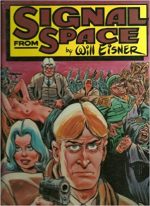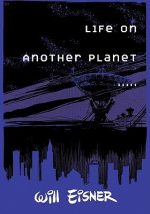


By Will Eisner with Andre LeBlanc (Kitchen Sink Press/DC Comics/W.W. Norton & Co)
ISBN: 978-0-87816-014-3 (Kitchen Sink colour HB): 0-87816-370-0 (KSP B&W PB):
978-1-56398-677-4 (DC Comics Library PB): 978-0-39332-812-7 (WW Norton PB)
Here’s a long-lost contemporary cartooning classic which – although readily available in a number of formats – is still seen best in its first release. Ambitious and deliberately targeting an adult book-reading rather than comics audience, this initial collection of Will Eisner’s trenchant political thriller-cum-social commentary proves once more that sometimes the medium really is the message…
William Erwin Eisner was one of the pivotal creators who shaped the American comicbook industry, with most of his works more or less permanently in print – as they should be. From 1936 to 1938 he worked as a jobbing cartoonist in the comics production hothouse known as the Eisner-Eiger Shop, creating strips for both domestic US and foreign markets.
Using the pen-name Willis B. Rensie he created and drew opening instalments for a huge variety of characters ranging from funny animal to historical sagas, Westerns, Detective fiction, aviation action thrillers… and superheroes… lots of superheroes …
In 1940 Everett “Busy†Arnold, head honcho of the superbly impressive Quality Comics outfit, invited Eisner to take on a new challenge. The Register-Tribune newspaper syndicate wanted a 16-page weekly comicbook insert for the Sunday editions. Eisner jumped at the opportunity to move beyond the limitations of the nickel and dime marketplace, creating three series which would initially be handled by him before two were delegated to supremely talented assistants.
Bob Powell inherited Mr. Mystic and distaff detective Lady Luck fell into the capable hands of Nick Cardy (then still Nicholas Viscardi) and later the inimitable Klaus Nordling.
Eisner kept the lead feature for his own and over the next twelve years The Spirit became the most impressive, innovative, imitated and talked-about strip in the business. However, by 1952 he had more or less abandoned it for more challenging and certainly more profitable commercial, instructional and educational strips. He began working extensively for the US military in manuals and magazines like P*S, the Preventative Maintenance Monthly, generally leaving comics books behind him.
After too long away from his natural story-telling arena, Eisner creatively returned to the streets of Brooklyn where he was born on March 6th 1906. After years spent inventing much of the visual semantics, semiotics and syllabary of the medium he dubbed “Sequential Art†in strips, comicbooks, newspaper premiums and instructional comics, he capped that glittering career by inventing the mainstream graphic novel, bringing maturity, acceptability and public recognition to English language comics.
In 1978 a collection of four original short stories in strip form were released as a single book: A Contract with God and Other Tenement Stories. All the material centred around 55 Dropsie Avenue, a 1930’s Bronx tenement housing impoverished Jewish and immigrant families. It changed the American perception of cartoon strips forever.
Eisner wrote and drew a further 20 further masterpieces, opening the door for all other comics creators to escape the funnybook and anodyne strip ghettos of superheroes, funny animals, juvenilia and “family-friendly†entertainment. At one stroke comics grew up.
Eisner was constantly pushing the boundaries of his craft, refining his skills not just on The Spirit but with his educational and promotional material. In A Contract with God he honed in on unexplored territory with truly sophisticated, mature themes worthy of Steinbeck or F. Scott Fitzgerald, using pictorial fiction as documentary to examine social experience.
One of the few genres where Eisner never really excelled was science fiction – and arguably he doesn’t in this tale either as, in Signal from Space, the big discovery is just a plot maguffin to explore politics, social interactions and greed – all premium Eisner meat…
As ‘Life on Another Planet’ the material in this collection was originally serialised as eight 16-page episodes in Will Eisner’s Spirit Magazine from October 1978 to December 1980, rendered in toned monochrome (a format adhered to and title revived in subsequent Kitchen Sink, DC and W.W. Norton collections).
However, for this luscious hardback, the auteur and long-time confederate Andre LeBlanc fully-painted the entire saga using evocative tones and hues to subtly enhance the sinister, cynical proceedings…
One momentous night, lonely radio astronomer Mark Argano – based at a New Mexico observatory – picks up ‘The Signal’: a mathematical formula originating from Barnard’s Star and thus proof positive of extraterrestrial intelligence…
One colleague wants to inform the public immediately, but Argano is adamant that they go slowly as he (secretly) harbours schemes to somehow “cash inâ€. Unfortunately, the other scientist he shares the secret with is a Soviet sleeper agent…
Almost immediately the first murder in a long and bloody succession is committed as various parties seek to use the incredible revelation to their own advantage. World-weary science advisor and maverick astrophysicist James Bludd is dispatched by the CIA to verify and control the situation, but he walks straight into a KGB ambush and narrowly escapes with his life…
There’s now a deadly Cold War race to control contact with the mysterious signallers and ‘The 1st Empire’ follows recovering addict Marco as he turns his life around; using the now-public sensation to create a personality cult dedicated to leaving Earth and joining the aliens. Whilst Marco’s Star People grab all the headlines, ruthless plutocrat Mr. MacRedy uses his monolithic Multinational Corporation to manipulate Russia and America, intending to be the only one to ultimately capitalise on any mission to Barnard’s Star…
Since travel to far space is still impossible for humans, MacRedy sanctions the unethical and illegal creation of a human/plant hybrid and starts looking for volunteers to experiment on in ‘A New Form of Life’, whilst Bludd – now more reluctant spy than dedicated scientist – accepts another undercover assignment.
Casualties moral, ethical and corporeal mount in ‘Pre-Launch’ whilst in distressed African nation Sidiami, a desperate despot declares his bankrupt nation a colony of Barnard’s Star to avoid UN sanctions and having to pay back his national debt to Earthly banks…
Soon, he’s offering a base to Multinational for their own launch site and sanctuary to those Star People anxious to emigrate…
In ‘Bludd’ the scientist and his sultry KGB counterpart find themselves odd-bedfellows just as the Mafia get involved in the crisis – for both personal and pecuniary reasons – whilst in America, MacRedy prepares to install his own President to expedite his company’s requirements…
Now determined to take matters into his own hands and screw all governments and interests, Bludd is caught up in an unstoppable, uncontrollable maelstrom of events in ‘Abort’, and, after the American President has a fatal accident in ‘The Big Hit’ MacRedy thinks he’s finally won. He is utterly unprepared for Bludd’s unpredictable masterstroke in ‘The Last Chapter’…
Signal from Space is a dark and nasty espionage drama as well as a powerfully intriguing ethical parable: a Petrie dish for ethical dilemmas where Eisner masterfully manipulates his vast cast to display human foible and eventually a glimmer of aspirational virtue. This is a hugely underrated tale from a master of mature comics guaranteed to become an instant favourite. And it’s even better in this sumptuous oversized edition which is well worth every effort to hunt it down.
After all, Per Ardua ad Astra…
However, if you can’t find this version, there are numerous later editions, in the original black & white that have their own potent appeal and if you were a really dedicated fan, you’d only be happy with both, wouldn’t you?
© 1978, 1979, 1980, 1983 Will Eisner. All rights reserved.
